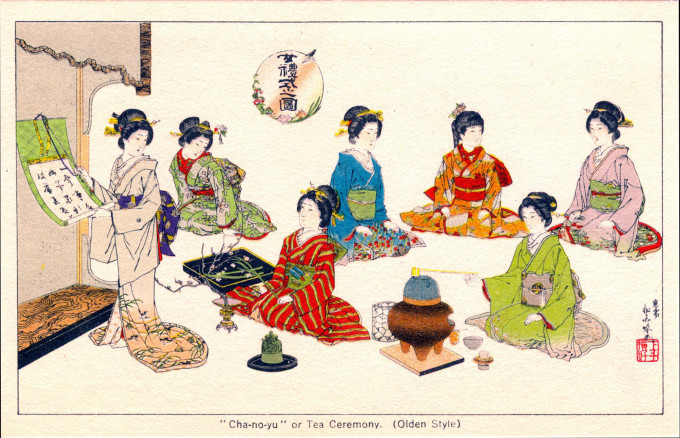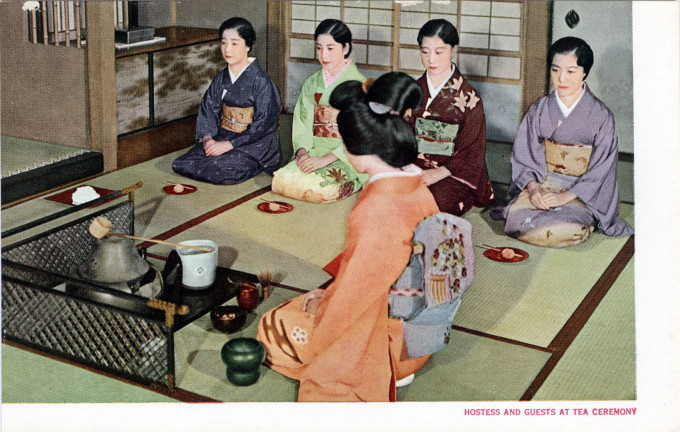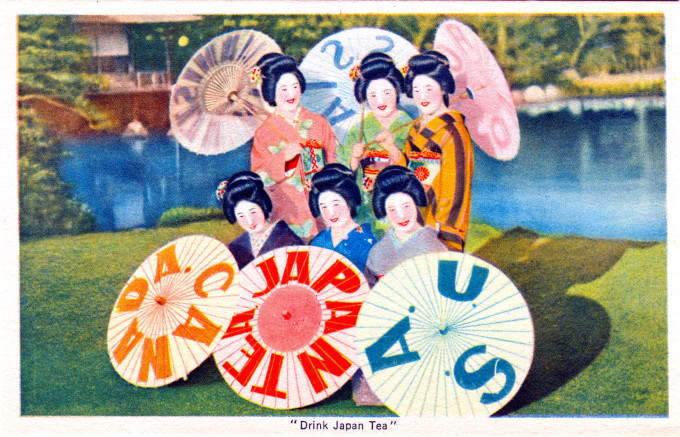
Reproduction of a woodblock print depicting the “cha-no-yu” (green tea ceremony), included in a packet promoting the Japan Tea Company c. 1950.
See also:
Tea picking at Uji, c. 1920
Tea time, c. 1910
Ochaya (tea house), c. 1910
“Tea drinking hardly would seem to come under the head of a sport or to appeal to a man who led a fast fierce life. But Sendai spent enough at it to make a dozen experts in its ceremonies independent for life.
“Of this pastime Professor Chamberlain says the Art of drinking tea has gone through three stages: medico-religious, luxurious, and aesthetic. It was the third stage that appealed to Sendai.
“The ceremony originated in a worthy cause. A priest named Eisai who wished to reform a youthful Shogun who drank too much sake and sham shiu, got him interested in tea by elaborating a set of rules for drinking it. When the ceremony was well established in the august favor the old priest gave the Shogun tracts on the beneficial effects of tea how it regulated the whole system and drove out devils – might indeed be preferred to the gold cure.
“Eisai worked in a good deal of religion along with his tea but the ceremony of drinking grew more and more worldly until it was all luxury and no religion. Even in such extravagant observance however tea drinking was not altogether an evil.
“While it lasted it gave great stimulus to art. Some of the finest specimens of native work date from the tea period. So Sendai may be said to have done good in a negative way – not meaning to, perhaps, but those of us who care for Japanese art may say ‘Thank you’ to him and his class, and drink his health from one of the famous bowls of the tea period.
– The Heart of Japan: Glimpses of Life and Nature Far from the Travellers Track in the Land of the Rising Sun, by Clarence Ludlow Brownell, 1903

Japanese tea ceremony (chanoyu), c. 1960. Zen Buddhism was a primary influence in its development, but chanoyu would evolve into an elaborate and refined ceremony meant to demonstrate respect through grace and good etiquette.
“The term ‘Cha-no-yu‘ is not, as may be imagined, a translation of the words ‘Tea Ceremony,’ but means literally ‘Hot water tea,’ or as it would read in French more elegantly ‘Thé a l’eau chaude‘ … There seems to be very little doubt that the drinking of tea, which commenced with the priests and religious orders, gradually developed into an excuse for a congenial gathering of friends and retainers, some times for political purposes, sometimes for learned or religious discourse, and later on with a more ethetic object.
“The very rules and regulations of Cha-no-yu point to its religious origin. The first meetings were, no doubt, held in the temples, situated in groves of beautiful trees, with picturesque surroundings ; consequently when these meetings came to be held by people in the town,s they tried to imitate these conditions by celebrating the tea ceremony in a little room, apart in a garden, often strewn with pine needles, to carry the resemblance still further; and again, one of the rules of Rikiu, the greatest of Cha-jin (tea experts), enforced the necessity of abstaining from frivolous conversation, while everything connected with the Cha-no-yu had to be performed with the utmost ceremony and decorum.”
– To Nippon, Land of the Rising Sun, by Wilson Le Couteur, 1899



Pingback: Tea picking at Uji, c. 1920. | Old Tokyo
Pingback: Tea time, c. 1910. | Old Tokyo
Pingback: Japanese Pavilion, A Century of Progress International Exposition, Chicago, 1933. | Old Tokyo
Pingback: Ochaya (Tea house), c. 1910. | Old Tokyo
Pingback: Ikebana (flower arrangement), c. 1910. | Old Tokyo
Pingback: Ikebana (flower arrangement), c. 1910. | aStory
Pingback: “Tea-farming”, c. 1920. | Old TokyoOld Tokyo